
Wine Culture and Information since 2002 - Volume 22
 Wine Culture and Information since 2002 - Volume 22 |
|
Issue 39, March 2006 |
Contents |
|
|
Wine and Communication |
|
Few months ago, DiWineTaste has released a new polls service in its WEB site. We did that because we think that listening to our reader's opinion is very important to us. We introduced some polls about communication and wine, and in January, we discovered interesting results. In first rank, at least up to now, you readers have voted “events and tasting”, at the second place “internet”, at the third “enological guides” and then “visits to wine-cellars”. These results are important and show how the preferences about media, involved in wine, have changed. The so called consumer awareness is more and more discussed and it is not by chance if wine lovers want to know more about it, to directly taste the product in occasion of enogastronomical or tasting events about a specific subject. Media talk a lot about wine and producers frequently debate about the numbers of events having the wine as a protagonist. Anyway, more and more people, younger and older, travel many kilometers in order to go to events, which give them the chance to taste their favorite wines as well as discovering new ones. The same consideration is true for the visits to wineries, which are getting more and more popular in Italy. There are, for example, wine lovers from abroad, which run across Italy by bus, in order to get to Sicily, with the specific intent of visit just one winery. Are they wine fundamentalists? No, as it simply is in our country as well as and abroad, the interest for the beverage of Bacchus and the will to understand it better are increasing more and more. Wineries are getting more and more organized, even by creating a real receptive service, made by experienced people capable of speaking different languages. Sometimes, the wineries give the chance, by paying an amount, to arrange a lunch, inside the winery itself, with typical local dishes. Wine lovers, among smell of wine and barrique, can experiment the synthesis between wine and terroir, to say it the French way. Many guides suggest which wineries are opened to visitors. And in Italy, there are many! Movies like “Sideways”, which tells the story of two friends visiting wineries in California, has created “the fashion of going around wineries”. Or events, such as the “Wine Day”, organized by Movimento del Turismo del Vino (Organization for Wine Tourism), have opened wineries to wine lovers while contributing to develop the culture of wine. We would however like to share a consideration with you: the second place of the polls is occupied by internet in the ranking of the preferred media for learning about wine. And we admit that, we are happy about this result, as we do our very best every month in order to give you our best, to share information about wine and other subjects about enogastronomy with you. Italy is among the countries in which newspapers are read by few people and this also applies to wine magazines, too. There surely are many reasons for this. The economical condition we are passing through, forces people to save the money for the subscription to a magazine or to buy it in the kiosk, because of its high cost. Or more simply, we have no time to go to the kiosk and to buy the preferred magazine, because we all are always in a hurry. Internet gives the chance, most of the times, to read free magazines about wine. Internet is easy to use, most of the time providing interactivity, such as our polls, guides and EnoGames, all being appreciated by our readers. Our web site, in Italian and English, is read not only in Italy, but also abroad, especially in the United States of America, Great Britain, Germany, France, Spain, Canada, Australia, Japan and South Korea. Wine is a very special product and communication about it is something of its own. Communicating wine is not the same of communicating a toothpaste. And this is not something clear to understand. According to some points of view, communication about wine is very traditional even nowadays, and most of the times it is simply too much! There are some communication media which are scarcely considered for the communication of wine, and sometimes they are not even considered at all. This is the case of cinema or television, for example. Only few wines for daily consumption are advertised on TV, while we rarely see a wine commercial at the cinema. Producers prefer to invest in communication on other media, especially on specialized magazines and on the ones destined to professionals (restaurants, wine-bars, pizza houses, hotels). Wine is communicated by public relations activities, by means of events organization, tasting, enogastronomical and cultural events. Moreover, producers usually meet wine professionals in occasion of exhibitions. An example is Vinitaly - which is organized in Verona, in April - the most important wine event in Italy, which attracts people from all the country and wineries from all over the world. A recent survey, made by the Italian press agency Ansa, put the attention on the diminishing interest for daily newspapers, while internet is getting more and more used for reading news. Although we are very sorry for the press, this seems to be a realistic scene. The investments on communication by producers do not take in consideration the trends about the fruition of communication media by consumers. This happens because most of Italian producers do not have access to data and researches or the chance to finance surveys, because they are too expensive. Communication is one of the point of marketing, which, at least in the wine field, is mainly done by intuition and not according to numbers and trends, which are in the hands of big companies. In the wine field, it is very difficult to see “real marketing”, because most of wine companies are not structured with a specialized sector. Today, many wine companies have a WEB site, but few take advantage of this dynamic mean. Many WEB sites are “static”, without even considering the characteristics this medium could offer, they are never updated or this rarely happens. Few companies, on the contrary, use internet to continuously communicate to their public (consumers, suppliers, buyers of great supermarkets chains, prospects) and we are not talking about wine e-commerce only, which in Italy does not take off, because buyers are afraid of using their credit cards on the internet or simply because they are not accustomed to that. In Italy, there are company web sites, very famous all over the world, which are not being updated for many years. Even companies having financial and human resources to do that, most of the times neglect this aspect. For small wine companies this is more difficult, but sometimes, their web sites are up to date. Internet is a medium offering huge potentialities and attract people of different ages, even older ones, but it is necessary to use it with a precise communication strategy, which is, most of the times, nonexistent. This is the real problem in the wine business: most of the cases, the lack of a marketing strategy, which includes the strategy of product, as well communication, distribution and price. There is still too much instinct in this field and wineries are too traditional.
|
||||
MailBox |
|
In this column are published our reader's mail. If you have any comment or any
question or just want to express your opinion about wine, send your letters to
our editorial or fill in
the form available at
our site.
|
| What is the “governo toscano” vinification system? |
| Paolo Vaccari -- Silea, Treviso (Italy) |
| The so-called “governo alla toscana” is an enological practice, very used in the past for the production of Chianti, while today there are few who use it. Technically speaking, it consists in favoring a slow refermentation, by adding to the wine the must of lightly dried grapes, belonging to the same harvest. After harvesting, part of the grapes - usually the best - is dried in aerated rooms. During December, after the first decanting, the dried grapes are crushed and the must is added to the new wine, causing a slow refermentation. This operation allows a longer keeping of the lively character of the wine as well as its crispness, as well as allowing the complete fermentation of sugars. Another similar technique - called “rigoverno” - is generally done in springtime, operation which gives the wine more color and richness of aromas. |
| What is the “Guyot” system? |
| Mario Silvestri -- Bologna (Italy) |
| Guyot is probably the most famous viticultural system, created by Dr. Jules Guyot, developed in two methods, simple Guyot - in short Guyot - and double Guyot. This viticultural system offers many advantages, such as the simplicity in pruning and harvesting - which it can be mechanized - ensures a good exposition of the leaves, an appropriate density of plants and a good quality of production. The system is realized by a proper method of pruning, in which the old vine stock, called cut of the past, that is the branch which bore the grapes for the last harvesting, is cut. Then, two new vine stocks are chosen: the first - cut of the present - destined to the production of grapes for the next harvesting and properly cut to a determined number of buds the second - called cut of the future - properly shortened to 2-3 buds, which will become, after harvesting, the new cut of the present. |
Montefalco SagrantinoIn Umbria, green region of central Italy, land of culture, art and ancient traditions, shines a star in the enological firmament which takes its origin from the land of Montefalco: Sagrantino |
|
Who could have ever thought that in Umbria, the region considered as the Green Heart of Italy - famous in the world for the bliss and quietness of its landscapes, full of peace and spirituality, land of saints and heroes - was able to show firmness and strength in one of its most famous wines? Sagrantino, the grape variety responsible for this prodigy, has been successful in a short period of time to firmly conquer the top of worldwide enology and its success is so resounding, that also other Italian regions begin to claim the chance of cultivating this grape in their territories. Sagrantino means Montefalco and Montefalco - according to an enological point of view - means Sagrantino. The connection between this land and its grape is strong since centuries, and no matter it will be, no one will be able to break this bond, because - since ever - Montefalco is Sagrantino. This is thanks to the firmness and obstinacy of local producers, which have been able to create a great wine from their great grape. A grape which has always had the main role in Montefalco's vineyards since ancient times, although - and it is good to remember - at the beginning of the 1970's, many people thought it would have been better to uproot Sagrantino from their vineyards and to replace it with other famous and profitable grape varieties, capable of ensuring a better selling. Only thanks to the obstinacy and commitment of some producers - convinced of the huge potentialities of their grape - that Sagrantino succeeded not only in saving itself, but also to reach the top of the worldwide enology. A long and difficult path of more than thirty years, which today it is repaying back the efforts of all producers - in particular of those who was the first ones to invest on Sagrantino grape, offering a great wine, a unique wine of its kind, to wine lovers. If only one thinks that at the beginning Sagrantino was only used for the production of a sweet and robust wine, strong in tannins, capable of being matched with succulent and tasty roast lambs typical of Easter lunch. In the course of the years, Sagrantino made its own way and the same is true for Montefalco as well - its land - thanks to a past and a tradition made not only by art and history, but also of wine.
Montefalco - suggestive city in the province of Perugia, also well known as the “railing of Umbria” - is the center of the wine production with Sagrantino grapes. Montefalco is encircled by its city walls of the 1300's, and besides of offering excellent wines, is rich in history, culture and art, such as the renowned and extraordinary Benozzo Gozzoli's frescoes in the church of Saint Francis - where today is found the Civic Museum - pieces of arts which are certainly worth of a visit to this Umbrian city, even better, while drinking a glass of a good Sagrantino. Montefalco is one of the few Italian cities in which the cultivation of vines was practiced inside the city walls, a tradition dating back to medieval times. Anyway, wine production in Montefalco dates back to even more ancient times. Pliny The Elder, in his monumental Naturalis Historia remembered that Itriola grape variety was cultivated in the areas of Mevania (the present city of Bevagna, located in the Sagrantino di Montefalco production's area) and Piceno: «Itriola Umbriae Mevanatique et Piceno agro peculiaris est». However, the ancient Itriola grape has no connection with Sagrantino, in fact in 1596 Andrea Bacci identified it with Passerina grape. The origin of Sagrantino grape is quite uncertain and there are many suppositions. Today, Sagrantino is however considered a local grape variety of Montefalco, it is said it was introduced in the fourteenth or fifteenth century by monks of the Franciscan order coming back from their preaching journeys in Asia Minor. Other theories about the origins of Sagrantino suggest this grape came from Spain or that was introduced by Arabs. No matter its origin, genetic researches on Sagrantino have not discovered analogies with other grape varieties. Thanks to the rich documentation in the historical archives of Montefalco, it can be said the Umbrian city has always had a special connection with the cultivation of grape and the production of wine. In fact, there are many documents which refers to vineyards sold or given to others - especially in form of wills - and there are many proves about the care and dedication of the vintners of those times for their vineyards, as well as specific laws about the safeguarding of the enological production. The most famous of them dates back to the fifteenth century - period in which the cultivation of the grapes was already practiced inside the city walls - in which was set that Whoever will be found to steal immature or ripe grapes and does not own a vineyard or has rent one, will be punished as he was entered in a vineyard of someone else and has gathered grapes». Vineyards and grapes were also safeguarded by specific laws which forbade - for example - non authorized extirpation. At that time, the production of wine played a fundamental role in the economy and culture of the city, in fact since 1540, the date of the beginning of harvesting was set by a proper town law. Still today, this event is alive thanks to Confraternita del Sagrantino (Confraternity of Sagrantino), which, in a specific date of September, publicly announces in a square the beginning of harvesting. The quality of Montefalco wine was also praised by Cipriano Piccolpasso - superintendent of the fortress of Perugia - during the writing of his work «Maps and descriptions of the city and lands subordinated to Perugia Government» in 1565. In this work - commissioned by the Papal State with the aim of drawing maps and “descriptions” of the preservation conditions of the fortresses in the province of Perugia - he wrote that in Montefalco were cultivated good vineyards from which were produced excellent wines. In the following centuries, Montefalco and its Sagrantino are frequently mentioned in other documents, always praising their enological qualities. In the occasion of “Umbrian Exhibition”, which took place in Perugia in 1899, Montefalco Sagrantino obtained an important award which was useful to its commercial revitalization. However, Sagrantino had - in the decades ahead - a substantial decline, so that in 1960's it was almost disappeared from Montefalco's vineyards. Other famous grapes, capable of promising success were taking the place in Montefalco's vineyards. It was thanks to the experiments done in 1970's by few and tenacious producers, which determined the triumphal return of Sagrantino grape in Montefalco. After many efforts and an endless passion, Montefalco traditional wines were radically changed, from a sweet wine - produced with the most traditional methods - it changed into a dry, robust and impressive wine; an enological innovation which gave Sagrantino a new role, which allowed it to reach the top of worldwide enology. Today, although the most famous Montefalco wine is produced in the dry style, Sagrantino also keeps intact its origin expressed by the robust and sweet wine, in which the tradition meets the modern enology for a new success, which seems to be almost unstoppable.
|
||||||||||||
|
Montefalco Sagrantino - or Sagrantino di Montefalco - is recognized by the Italian quality system as DOCG wine (Denominazione d'Origine Controllata e Garantita, Denomination of Controlled and Guaranteed Origin), obtained in 1992. According to the production's disciplinary, the wine can be produced exclusively with 100% Sagrantino grapes. Montefalco Sagrantino can be produced uniquely in the commune of Montefalco - from which the DOCG is named after - and part of the territory in the communes of Bevagna, Gualdo Cattaneo, Castel Ritaldi and Giano dell'Umbria, in the province of Perugia. Montefalco Sagrantino is produced in the styles secco (dry) - whose history is of 30 years - and passito (sweet wine), belonging to the enological tradition of the area. According to the disciplinary, the maximum yield in vineyards must not exceed 80 quintals per hectare, the maximum yield of the grape must not to be lesser than 65% for the dry style, lesser than 45% for the sweet style. Dry Sagrantino must have - according to the disciplinary - an alcoholic volume of at least 13%, and of 14.5% for the sweet style. As for aging periods, these are set according to the kind of wine. Dry Montefalco Sagrantino can be sold only after a period of almost 30 months of aging, 12 of which in cask. Montefalco Sagrantino Passito must be aged for at least 30 months. The period of aging begins - in both cases - from the first of December following harvesting. Because of the characteristics of Sagrantino grape - having one of the highest concentration of polyphenols among the grapes in the world - a period of at least 30 months allow tannins to properly mature, while giving a better balance to the wine, therefore becoming less aggressive. In the same production area of DOCG is also defined the area of Montefalco Rosso and Montefalco Bianco wines (Red Montefalco and White Montefalco), both recognized as DOC (Denominazione d'Origine Controllata, Denomination of Controlled Origin).
|
|
Sagrantino is a unique grape of this kind. It is unique not only because it is cultivated in a pretty small territory, but it is especially unique for the wine which is capable of producing, which is unique, too. The connection between Sagrantino and its territory - which is also responsible for this enological masterpiece - gives a great, strong and powerful wine to the palates of wine lovers, and it may surprise such a wine can be produced in the mild and quiet Umbria. Thanks to its thick skin rich in tannins - Sagrantino is among the grapes having the highest concentration of polyphenols - mould and the attack of parasites are limited, however it is this high quantity of tannins to make Sagrantino an invincible and rebel grape in the cellar. It is only through the complete maturation of tannins, in the vineyard first and then in the cellar - also responsible for Sagrantino's robust body and strength - that the wine will lose its remarkable astringency, while getting a smoother and velvety character. However a glass of good Sagrantino begins to fascinate the taster with its dark and deep red color and, after passing it under the nose, it is pretty hard to be indifferent to its strong aromas of black fruits, especially blackberry, the characteristic fruity aroma identifying this grape. Sagrantino's characteristics also allow its clusters to be left for months to dry without getting spoiled: it is thanks to this important operation are being obtained the grapes for the production of the passito style (sweet), the most traditional and ancient wine of the area. Sagrantino Passito - frequently considered a dessert wine because of its sweetness - was indeed used by the people of these lands as a wine to be matched to robust roast lamb in occasion of Easter lunch. Sagrantino Passito - which is certainly good to be matched to desserts, included the ones made of chocolate - is also good for the matching with mature pecorino cheeses produced in Umbria. Since 1981, the producers of Montefalco have established “Consorzio Tutela Vini Montefalco” (Consortium for the Safeguarding of Montefalco Wines), with the aim of coordinating the wineries in researching quality and in the valuation of the wines of the territory. Moreover, the Consortium is involved in the safeguarding of the viticulture and wine production of this area, the safeguarding and promotion of Montefalco's wines, supervise the respect of the production disciplinary, as well as providing agronomic and enological technical assistance its members. In the same territory of Motefalco Sagrantino production area is also defined the production area of Montefalco DOC (Denominazione d'Origine Controllata, Denomination of Controlled Origin), which shares most of its area with the one of Denominazione d'Origine Controllata Colli Martani. Montefalco DOC is produced in three styles: White, Red and Red Reserve. Montefalco Bianco is produced with at least 50% of Grechetto grape - autochthonous white grape variety of Umbria - 20-35% of Trebbiano Toscano and the remaining part of authorized white grapes. Although the most famous grape of Montefalco is Sagrantino, the main protagonist in DOC red wines is Sangiovese. Montefalco Rosso and Montefalco Rosso Riserva are in fact produced with 70% of Sangiovese grape, 10-15% of Sagrantino grape and the remaining part with authorized red grapes. As for aging periods, Montefalco Rosso must age for a minimum of 18 months, while for Montefalco Rosso Riserva the minimum period is 30 months, of which 12 in cask.
|
Comparing Sauvignon BlancFamous grape for its aromatic wines, having a crisp taste in which its zesty acidity is the protagonist, is the triumph of flowers and fruits, as well as particular and complex aromas |
|
Sauvignon Blanc is among the few international grapes to belong to the family of aromatic varieties. Sauvignon Blanc is also a white grape which is loved or hated, because of its particular aromas, which are frequently so strong and dominant and therefore not all may like them. Indeed, the aromatic profile of Sauvignon Blanc is strongly influenced by climate, land and - in particular - ripeness, factors that, of course, influence the organoleptic quality of every grape. However, these factors in Sauvignon Blanc, in particular ripeness, determine a big difference in the development of “green” and pungent aromas - which are generally obtained with less ripe grapes and cultivated in cool climate areas - and in flowers and fruit aromas, result of riper grapes or cultivated in warm climate areas. As opposed to the majority of grapes, in which vinification techniques in steel tanks or in barrel are equally used, Sauvignon Blanc is rarely fermented or matured in cask, even less in barrique. In case wood is used, its contribution is usually discreet without excessively covering the aromatic nature of the grape, although this enological practice gives Sauvignon Blanc wines with a good body and longevity. Thanks to its specific aromatic quality, Sauvignon Blanc is the main protagonist of many wines, in which it is used together to other grapes, both to give more acidity as well as to enrich the aromatic profile. In the wines in which it is present, the “touch” of Sauvignon Blanc is almost impossible to be missed: its strong aromas of fruits, even tropical ones, always add a distinctive and elegant note.
|
The goal of this month's comparative tasting is the study of the organoleptic qualities of Sauvignon Blanc, according to the wine making techniques used for its production. The wines selected for the comparative tasting are all produced in the eastern part of northern Italy - Friuli Venezia Giulia and Alto Adige - regions which offer cool climate conditions useful for the cultivation of Sauvignon Blanc. Another reason which determined our choice is represented by the aromatic qualities of the wines, in which it will be possible to appreciate the “green” aromas of Sauvignon Blanc as well as the aromatic qualities of fruits and flowers. The wine making technique of the three wines will help us to better understand this grape as well. The three wines have been produced with three different wine making techniques: one is entirely produced in steel tanks, one is entirely aged in cask, while only a part of the third wine ages in cask. The first wine of our comparative tasting is Collio Sauvignon De La Tour of Villa Russiz. This excellent wine is the only one of the three completely aged in steel tanks, in this specific case for 10 months. The second selected wine is produced in Friuli Venezia Giulia as well, although in a different area: Friuli Isonzo Sauvignon Picol from Lis Neris. A part of this wine ages in cask, a characteristic which will give the wine a fuller body. The third wine is Cantina Terlano's Alto Adige Terlano Sauvignon Quarz; this is the only wine completely aged in cask, in this case for 8 months. In order to better appreciate the organoleptic qualities of our three Sauvignon Blanc, the wines will be served at a temperature of 10° C (50° F). The vintages of the wines to be used for the tasting will belong the latest harvesting: Sauvignon Blanc is a wine to be consumed young in order to enjoy its best qualities. The tasting will be done by using three ISO glasses.
|
||||||||
|
The wines produced with Sauvignon Blanc do not show intense colors. The reason is not to be uniquely found in the quality of the grape, but also in the way Sauvignon Blanc is vinified. The most common used technique, as already mentioned, provides the use of inert tanks - such as steel and cement - rarely the cask or barrique. The color of the wines produced with Sauvignon Blanc basically show hues from greenish-yellow to straw-yellow. The color tends to get darker in case the cask is being used: in this case it can observed even gold yellow hues. As the wines produced with Sauvignon Blanc should preferably be consumed young, in order to better appreciate the crisp and aromatic character of fruits and flowers, it is not very useful talking about the development of its color in function of time. The first wine of which we will evaluate color is Collio Sauvignon De La Tour of Villa Russiz, the only one of the three to be completely vinified in steel tanks. By observing the wine at the base of the glass, it will be noticed an intense greenish-yellow color and greenish-yellow nuances, very transparent. The second wine we will evaluate is Friuli Isonzo Sauvignon Picol of Lis Neris: it can be observed a brilliant greenish-yellow and greenish-yellow nuances, even in this case, very transparent. The aging of part of the wine in cask does not seem to have influenced the color. The last wine of which we will evaluate the color is Cantina Terlano's Alto Adige Terlano Sauvignon Quarz, the only one of the three to be completely aged in cask. In this wine, although showing a greenish-yellow color, it will be observed the hue is slightly more intense than the previous ones, while the nuance does not differ from the other wines.
|
|
One of the most interesting and intriguing aspects of Sauvignon Blanc is represented by its aromas. Sauvignon Blanc is considered a semi-aromatic grape, that is a grape having aromas directly recalling the grape. Whereas in aromatic grapes, the intensity of this aroma is pretty strong, in Sauvignon Blanc is less evident, although present. The main aromatic quality of Sauvignon Blanc is not the one of grape, indeed the others aromas which made this grape famous. In particular, Sauvignon Blanc is famous for its “green” and unripe aromas of bell pepper, and even more for an aroma which is not considered agreeable, that is cat's pee, associable to box flower. These special aromas are typical of Sauvignon Blanc cultivated in areas with cool climate or vinified when it has not reached full ripeness, otherwise, the aromas of this grape are an explosion of flowers and fruits, including tropical ones. We will start the aromatic evaluation of our wines, starting from the only one matured in steel vats: Collio Sauvignon De La Tour di Villa Russiz. Maintaining the glass still and in a vertical position, we evaluate the opening aromas, which in this wine will be of peach, elderberry and pineapple. The peach is a typical aroma of Sauvignon Blanc, probably the fruit which we find again more frequently in this grape. We can affirm the same for elderberry flower, other aromatic element distinguishing Sauvignon Blanc. After having swirled the glass, the aromatic sequence will be completed by acacia, litchi, apple, broom, grapefruit, the typical pepper and - at the end a pleasant signs of sage. Although the aromatic impact of this wine is pleasantly oriented to fruity notes, the presence of vegetal aromas - such as pepper and sage - are almost evident and rend more pleasant the aromatic profile of the wine. The second wine of which we will evaluate aromas is Friuli Isonzo Sauvignon Picol of Lis Neris. The opening aromas reveal herbaceous and vegetal hints of box flower, green bell pepper and tomato leaf, three typical aromas of Sauvignon Blanc cultivated in cool climate areas. After having swirled the glass, it will possible to perceive aromas of elder, sage, peer, peach, pineapple, lemon and pleasant hints of mineral aromas. The last wine to be evaluated is Cantine Terlano's Alto Adige Terlano Sauvignon Quarz, the only one of the three to be aged in cask. The opening aromas will be characterized by hints of passion fruit and peach. By continuing the olfactory evaluation - after having swirled the glass - we will perceive aromas of litchi, broom, mineral, elder, nettle, pineapple, bell pepper, sage and hints of vanilla which does not disturb the personality of the wine. It should be noticed how in this wine the typical vegetal aromas of Sauvignon Blanc are present, such as bell pepper, sage and elder flower.
|
||||
|
The wines produced with Sauvignon Blanc are characterized to the taste with two main qualities: acidity and body. Wines produced with this grape generally have a pretty strong and evident acidity, a quality which is useful their in wines produced with round and ripe grapes, positively contributing to the balance. The body of Sauvignon Blanc wines is generally weak; this does not mean this grape make light and weak wines, it just means the wines are not robust, such as the ones produced with Chardonnay grapes. These two characteristics are however determined by the use of tanks for the aging of wines. In case in which a cask or a barrique is being used, the acidity tends to get smoother, while the body will be fuller; in both cases because of wood's tannins passed to the wine. We will begin the gustatory evaluation from Collio Sauvignon De La Tour of Villa Russiz. The attack of this wine will be pretty crisp: the acidity will be pretty evident, although well balanced by alcohol. The correspondence to the nose is excellent, it will be possible to clearly recognize the flavors of peach, pineapple and peer. The second wine we will evaluate is Friuli Isonzo Sauvignon Picol of Lis Neris. The attack of this Sauvignon Blanc is characterized by its crisp acidity, also in this case with a very good balance given by alcohol. As opposed to the previous wine, we can notice how the body is slightly fuller: by holding the wine in the mouth and sliding the tongue against the palate, we will notice a lesser friction. The last wine we will evaluate is Cantine Terlano's Alto Adige Terlano Sauvignon Quarz, completely aged in cask. Despite the wine making technique used for its production, the attack is also in this case characterized by a pleasant crispness, with a good balance given by alcohol, we will notice a higher smoothness and a fuller body, which however does not negatively influence on Sauvignon Blanc's nature.
|
|
The three wines of our comparative tasting are three excellent examples of wines produced with Sauvignon Blanc grape. Even the use of cask - in the wines produced with this technique - have a good balance without negatively influencing the personality of Sauvignon Blanc. The finish of the three wines will be characterized - besides an excellent taste-olfactory persistence - for the clear flavor of peach, to which are followed flavors of peer and tropical fruits, such as pineapple, litchi and passion fruit. The magic of Sauvignon Blanc is also to leave in the mouth fresh and intense aromas of fruit and - frequently - to the nose can be perceived vegetal aromas such as green bell pepper and box flower, a quality which, however, is typical in wines produced with unripe grapes or cultivated in cool climate areas only. In all the other cases, Sauvignon Blanc is the triumph of flowers and fruit, where - at least this time - the cask and wood play a marginal role, or more frequently, are completely absent from the scene.
|
Wines of the Month |
|
|
|
Score legend Prices are to be considered as indicative. Prices may vary according to the country or the shop where wines are bought |
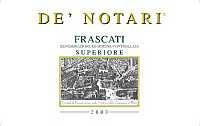
|
|
Frascati Superiore De' Notari 2004 |
|
| Cantine San Marco (Latium, Italy) | |
| Grapes: Malvasia del Lazio (50%), Bellone (20%), Trebbiano Toscano (15%), Malvasia di Candia (15%) | |
| Price: € 9.00 | Score: |
| This Frascati shows a brilliant greenish yellow color and nuances of greenish yellow, very transparent. The nose denotes intense, clean, pleasing and refined aromas which start with hints of apple, pear and hawthorn followed by aromas of peach, plum, broom and almond. The mouth has good correspondence to the nose, a crisp attack and however balanced by alcohol, good body, intense flavors. The finish is persistent with flavors of pear and apple. | |
| Food Match: Fried fish, Sauteed fish, Pasta and risotto with fish, Sauteed white meat | |

|
|
Solo Shiraz 2004 |
|
| Cantine San Marco (Latium, Italy) | |
| Grapes: Syrah | |
| Price: € 12.00 | Score: |
| This wine shows a brilliant ruby red color and nuances of ruby red, moderate transparency. The nose reveals intense, clean, pleasing and refined aromas that start with hints of black cherry and black currant followed by aromas of blueberry, blackberry, plum, violet and carob. The mouth has good correspondence to the nose, a slightly tannic attack and however balanced by alcohol, good body, intense flavors. The finish is persistent with flavors of black cherry, black currant and plum. | |
| Food Match: Broiled meat and barbecue, Stewed meat | |
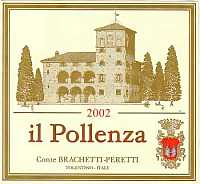
|
|
Il Pollenza 2002 |
|
| Il Pollenza (Marches, Italy) | |
| Grapes: Cabernet Sauvignon, Merlot | |
| Price: € 40.00 | Score: |
| The wine shows an intense ruby red color and nuances of garnet red, little transparency. The nose denotes intense, clean, pleasing, refined and elegant aromas which start with hints of black cherry, plum and black currant followed by aromas of blueberry, blackberry, violet, vanilla, licorice, tobacco, chocolate, cinnamon and hints of menthol. The mouth has good correspondence to the nose, a tannic attack and however balanced by alcohol, full body, intense flavors, agreeable. The finish is persistent with flavors of black cherry, plum and black currant. A well made wine. Il Pollenza ages for 13 months in barrique followed by 12 months of aging in bottle. | |
| Food Match: Braised and stewed meat, Roasted meat, Hard cheese | |
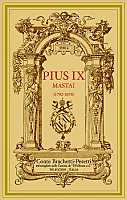
|
|
Pius IX Mastai 2003 |
|
| Il Pollenza (Marches, Italy) | |
| Grapes: Gewürztraminer, Sauvignon Blanc | |
| Price: € 20.00 - 50cl | Score: |
| The wine shows a brilliant amber yellow color and nuances of amber yellow, transparent. The nose reveals intense, clean, pleasing, refined and elegant aromas which start with hints of dried fig, almond and apricot followed by aromas of raisin, candied fruit, quince jam, peach jam, date, yellow rose, honey, orange peel and hints of lavender. The mouth has good correspondence to the nose, a sweet attack and pleasing smoothness, however balanced by alcohol, good body, intense flavors, agreeable. The finish is persistent with flavors of dried fig, apricot and raisin. A well made wine. Pius IX Mastai ages for 15 months in cement tanks. | |
| Food Match: Hard and piquant cheese, Fruit tarts, Confectionery | |
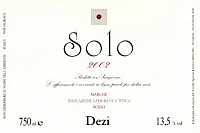
|
|
Solo 2002 |
|
| Dezi (Marches, Italy) | |
| Grapes: Sangiovese | |
| Price: € 28.00 | Score: |
| This wine shows an intense ruby red color and nuances of garnet red, little transparency. The nose reveals intense, clean, pleasing and refined aromas which start with hints of plum and black cherry followed by aromas of violet, blueberry, vanilla, licorice, tobacco, carob and hints of lavender. The mouth has good correspondence to the nose, a tannic attack and however balanced by alcohol, good body, intense flavors, agreeable. The finish is persistent with flavors of plum, black cherry and blueberry. Solo ages in barrique for 14 months followed by 12 months of aging in bottle. | |
| Food Match: Broiled meat and barbecue, Roasted meat, Braised and stewed meat with mushrooms | |
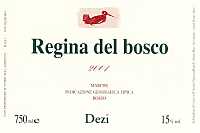
|
|
Regina del Bosco 2001 |
|
| Dezi (Marches, Italy) | |
| Grapes: Montepulciano | |
| Price: € 27.00 | Score: |
| This wine shows an intense ruby red color and nuances of ruby red, little transparency. The nose reveals intense, clean, pleasing, refined and elegant aromas which start with hints of plum and black currant followed by aromas of black cherry, blueberry, vanilla, tobacco, licorice, vanilla, cocoa, mace and hints of eucalyptus. The mouth has good correspondence to the nose, a tannic attack and however balanced by alcohol, full body, intense flavors, agreeable. The finish is persistent with flavors of black cherry, blueberry and plum. A well made wine. Regina del Bosco ages for 24 months in barrique followed by 12 months of aging in bottle. | |
| Food Match: Game, Roasted meat, Stewed and braised meat, Hard cheese | |
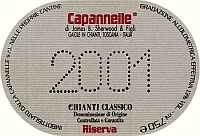
|
|
Chianti Classico Riserva 2001 |
|
| Capannelle (Tuscany, Italy) | |
| Grapes: Sangiovese, Colorino, Canaiolo Nero | |
| Price: € 30.00 | Score: |
| This Chianti Classico shows an intense ruby red color and nuances of garnet red, little transparency. The nose reveals intense, clean, pleasing, refined and elegant aromas which start with hints of black cherry and plum followed by aromas of violet, black currant, blackberry, blueberry, vanilla, tobacco, licorice, chocolate, cinnamon and hints of menthol. The mouth has good correspondence to the nose, a tannic attack and however balanced by alcohol, full body, intense flavors, agreeable. The finish is persistent with flavors of black cherry, plum and blueberry. A well made wine. This Chianti Classico ages for 18 months in cask. | |
| Food Match: Roasted meat, Stewed and braised meat, Hard cheese | |
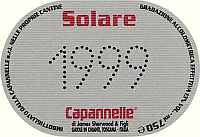
|
|
Solare 1999 |
|
| Capannelle (Tuscany, Italy) | |
| Grapes: Sangiovese, Malvasia Nera | |
| Price: € 55.00 | Score: |
| Solare shows an intense ruby red color and nuances of garnet red, little transparency. The nose reveals intense, clean, pleasing, refined and elegant aromas which start with hints of black cherry and blackberry followed by aromas of blueberry, plum, black currant, violet, vanilla, licorice, tobacco, chocolate, mace and hints of black pepper. The mouth has good correspondence to the nose, a tannic attack and however balanced by alcohol, full body, intense flavors, agreeable. The finish is persistent with flavors of black cherry, plum and blueberry. A well made wine. Solare ages for 18-24 months in barrique. | |
| Food Match: Game, Roasted meat, Braised and stewed meat, Hard cheese | |
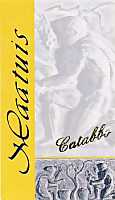
|
|
Falanghina del Molise Xaatuis 2004 |
|
| Catabbo (Molise, Italy) | |
| Grapes: Falanghina | |
| Price: € 13.00 | Score: |
| The wine shows a brilliant straw yellow color and nuances of greenish yellow, very transparent. The nose reveals intense, clean and pleasing aromas which start with hints of apple and plum followed by aromas of broom, pear, hawthorn, almond and hints of vanilla. The mouth has good correspondence to the nose, a crisp attack and however balanced by alcohol, good body, intense flavors. The finish is persistent with flavors of apple and plum. This wine ages for 5 months in barrique. | |
| Food Match: Fried fish, Fish soups, Broiled crustaceans, Sauteed white meat | |
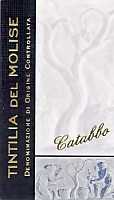
|
|
Tintilia del Molise 2004 |
|
| Catabbo (Molise, Italy) | |
| Grapes: Tintilia | |
| Price: € 18.00 | Score: |
| This wine shows an intense ruby red color and nuances of ruby red, moderate transparency. The nose reveals intense, clean, pleasing and refined aromas which start with hints of black cherry and plum followed by aromas of blackberry, cyclamen, raspberry, blueberry and violet. The mouth has good correspondence to the nose, a tannic attack and however balanced by alcohol, good body, intense flavors. The finish is persistent with flavors of black cherry and plum. This wine ages for 7 months in steel tanks. | |
| Food Match: Broiled meat and barbecue, Roasted meat, Stewed meat with mushrooms | |
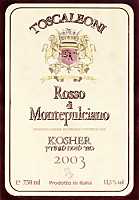
|
|
Rosso di Montepulciano 2003 |
|
| Toscaleoni (Tuscany, Italy) | |
| Grapes: Prugnolo Gentile (80%), Canaiolo Nero (15%), Mammolo (5%) | |
| Price: € 15.00 | Score: |
| The wine shows a brilliant ruby red color and nuances of orange red, moderate transparency. The nose denotes intense, clean and pleasing aromas which start with hints of cherry and plum followed by aromas of raspberry, blackberry, toasted wood, violet, vanilla and carob. The mouth has good correspondence to the nose, a slightly tannic attack and pleasing crispness, however balanced by alcohol, good body, intense flavors. The finish is pretty persistent with flavors of cherry and plum. This Rosso di Montepulciano is a kosher wine. | |
| Food Match: Broiled meat and barbecue, Stewed meat with mushrooms | |
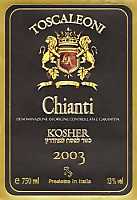
|
|
Chianti 2003 |
|
| Toscaleoni (Tuscany, Italy) | |
| Grapes: Sangiovese (80%), Canaiolo Nero (10%), Trebbiano Toscano, Malvasia del Chianti (10%) | |
| Price: € 12.50 | Score: |
| This Chianti shows a brilliant ruby red color and nuances of garnet red, moderate transparency. The nose denotes intense, clean and pleasing aromas that start with hints of cherry and plum followed by aromas of cyclamen, violet, toasted wood, vanilla, licorice and carob. The mouth has good correspondence to the nose, a slightly tannic attack and however balanced by alcohol, good body, intense flavors. The finish is persistent with flavors of cherry and plum. This Chianti is a kosher wine. | |
| Food Match: Broiled meat and barbecue, Stewed meat with mushrooms | |
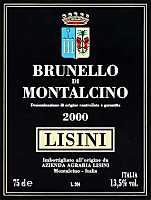
|
|
Brunello di Montalcino 2000 |
|
| Lisini (Tuscany, Italy) | |
| Grapes: Sangiovese Grosso | |
| Price: € 33.00 | Score: |
| This Brunello di Montalcino shows an intense ruby red color and nuances of garnet red, moderate transparency. The nose reveals intense, clean, pleasing, refined and elegant aromas which start with hints of black cherry, plum and violet followed by aromas of vanilla, tobacco, licorice, chocolate, cinnamon, mace, menthol and hints of tar. The mouth has good correspondence to the nose, a tannic attack and however balanced by alcohol, full body, intense flavors, agreeable. The finish is persistent with flavors of black cherry and plum. A well made wine. This Brunello di Montalcino ages for 36 months in cask followed by 6-8 months of aging in bottle. | |
| Food Match: Game, Roasted meat, Stewed and braised meat, Hard cheese | |
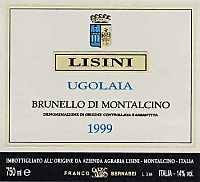
|
|
Brunello di Montalcino Ugolaia 1999 |
|
| Lisini (Tuscany, Italy) | |
| Grapes: Sangiovese Grosso | |
| Price: € 52.00 | Score: |
| Brunello di Montalcino Ugolaia shows a brilliant ruby red color and nuances of garnet red, little transparency. The nose reveals intense, clean, pleasing, refined and elegant aromas which start with hints of violet and black cherry followed by aromas of blueberry, plum, blackberry, vanilla, tobacco, licorice, cocoa, cinnamon, mace, menthol and hints of leather. The mouth has good correspondence to the nose, a tannic attack and however balanced by alcohol, full body, intense flavors, agreeable. The finish is very persistent with long flavors of black cherry, plum and blueberry. A well made wine. This Brunello di Montalcino ages for 36 months in cask followed by 18 months of aging in bottle. | |
| Food Match: Game, Roasted meat, Braised and stewed meat, Hard cheese | |
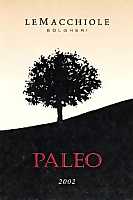
|
|
Paleo Rosso 2002 |
|
| Le Macchiole (Tuscany, Italy) | |
| Grapes: Cabernet Franc | |
| Price: € 50.00 | Score: |
| This wine shows an intense ruby red color and nuances of ruby red, little transparency. The nose reveals intense, clean, pleasing, refined and elegant aromas which start with hints of black cherry, black currant and plum followed by aromas of blueberry, blackberry, violet, bell pepper, vanilla, tobacco, mace, licorice, chocolate and pink pepper. The mouth has good correspondence to the nose, a tannic attack and pleasing roundness, however balanced by alcohol, full body, intense flavors, agreeable. The finish is persistent with flavors of black cherry, black currant and plum. A well made wine. Paleo Rosso ages for 18 months in barrique. | |
| Food Match: Game, Roasted meat, Braised and stewed meat, Hard cheese | |

|
|
Salice Salentino Bianco Tinaia 2003 |
|
| Cantine Due Palme (Apulia, Italy) | |
| Grapes: Chardonnay | |
| Price: € 8.60 | Score: |
| This wine shows a brilliant golden yellow color and nuances of golden yellow, very transparent. The nose reveals intense, clean, pleasing and refined aromas which start with hints of banana and plum followed by aromas of pineapple, acacia, grapefruit, pear, apple, hawthorn and hints of vanilla. The mouth has good correspondence to the nose, a crisp attack and pleasing roundness, however balanced by alcohol, good body, intense flavors. The finish is persistent with flavors of apple, banana and plum. Tinaia ages in barrique. | |
| Food Match: Stuffed pasta, Roasted white meat, Roasted fish | |
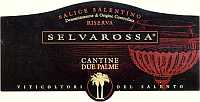
|
|
Salice Salentino Selvarossa Riserva 2000 |
|
| Cantine Due Palme (Apulia, Italy) | |
| Grapes: Negroamaro (90%), Malvasia Nera (10%) | |
| Price: € 21.00 | Score: |
| This Salice Salentino shows a brilliant ruby red color and nuances of ruby red, little transparency. The nose reveals intense, clean, pleasing, refined and elegant aromas which start with hints of black cherry and plum followed by aromas of blueberry, blackberry, vanilla, tobacco, licorice, star anise, clover and cinnamon. The mouth has good correspondence to the nose, a tannic attack and pleasing roundness, however balanced by alcohol, full body, intense flavors, agreeable. The finish is persistent with flavors of black cherry, plum and blackberry. A well made wine. This Salice Salentino ages for 12 months in barrique followed by at least 4 months of aging in bottle. | |
| Food Match: Game, Roasted meat, Stewed and braised meat, Hard cheese | |
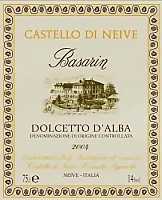
|
|
Dolcetto d'Alba Basarin 2004 |
|
| Castello di Neive (Piedmont, Italy) | |
| Grapes: Dolcetto | |
| Price: € 12.00 | Score: |
| The wine shows a brilliant ruby red color and nuances of purple red, moderate transparency. The nose denotes intense, clean, pleasing and refined aromas which start with hints of black cherry and blueberry followed by aromas of raspberry, blackberry, strawberry, plum and violet. The mouth has good correspondence to the nose, a slightly tannic attack and pleasing crispness, however balanced by alcohol, good body, intense flavors. The finish is persistent with flavors of black cherry and blueberry. | |
| Food Match: Broiled meat and barbecue, Stewed meat and mushrooms | |
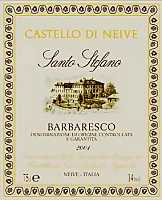
|
|
Barbaresco Santo Stefano 2001 |
|
| Castello di Neive (Piedmont, Italy) | |
| Grapes: Nebbiolo | |
| Price: € 30.00 | Score: |
| The wine shows a pale ruby red color and nuances of brick red, moderate transparency. The nose denotes intense, clean, pleasing, refined and elegant aromas which start with hints of cherry and violet followed by aromas of raspberry, rose, plum, vanilla, tobacco, licorice, cinnamon, chamomile, thyme and hints of menthol. The mouth has good correspondence to the nose, a tannic attack and appreciable crispness, however balanced by alcohol, full body, intense flavors. The finish is persistent with flavors of cherry and plum. A well made Barbaresco. | |
| Food Match: Game, Roasted meat, Braised and stewed meat, Hard cheese | |
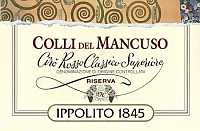
|
|
Cirò Rosso Classico Superiore Riserva Colli del Mancuso 2001 |
|
| Ippolito (Calabria, Italy) | |
| Grapes: Gaglioppo | |
| Price: € 12.00 | Score: |
| This Cirò Rosso shows a brilliant ruby red color and nuances of orange red, moderate transparency. The nose denotes intense, clean, pleasing and refined that start with hints of black cherry and plum followed by aromas of blueberry, dried violet, vanilla, tobacco, black pepper, cocoa, licorice and hints of nutmeg. The mouth has good correspondence to the nose, a tannic attack and pleasing crispness, however balanced by alcohol, good body, intense flavors. The finish is persistent with flavors of black cherry and plum. Colli del Mancuso ages for 8 months in barrique. | |
| Food Match: Roasted meat, Stewed and braised meat, Hard cheese | |
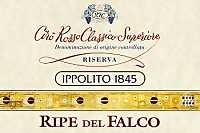
|
|
Cirò Rosso Classico Superiore Riserva Ripe del Falco 1991 |
|
| Ippolito (Calabria, Italy) | |
| Grapes: Gaglioppo | |
| Price: € 24.00 | Score: |
| This wine shows a brilliant ruby red color and nuances of brick red, moderate transparency. The nose reveals intense, clean, pleasing, refined and elegant aromas which start with hints of plum jam and black cherry jam followed by aromas of cherry macerated in alcohol, blueberry jam, dried violet, vanilla, tobacco, licorice, leather, cocoa, cinnamon, mace and black pepper. The mouth has good correspondence to the nose, a tannic attack and appreciable crispness, however balanced by alcohol, full body, intense flavors. The finish is persistent with flavors of plum jam and black cherry jam. A well made wine. Ripe del Falco ages for 12 months in barrique followed by a long aging in steel tanks. | |
| Food Match: Game, Roasted meat, Braised and stewed meat, Hard cheese | |
Cantine SettesoliLeading Sicilian wine company for turnover and volume of production, with Mandrarossa wines, top products of the winery, it joins tradition with innovation |
|
Cantine Settesoli is the leading Sicilian wine company for turnover and volume of production. The winery, located in Menfi, in the province of Agrigento, has a turnover of 36 millions euros and a production of 15 millions of bottles. Settesoli is a very well known brand and a cooperative company with 2,300 partners which proved grapes; the president is Diego Planeta and the general manager is Salvatore Li Petri. Cantine Settesoli, established in 1965 with the goal of coordinating, qualifying and promoting the enotechnological heritage of Menfi's territory. Today, this company is one of the Sicilian wineries which has been capable of joining tradition and innovation in a better way: the company experiments with international grape varieties, releasing new wines with a proper branding created some years ago and which connotes the wines of the top line: Mandrarossa. The brand is named after an area on the sea of Menfi, with a particular wine vocation. Mandrarossa is a brand, destined to attentive consumers, refined and who pay attention on the balance involving wine, culture and tradition of the production of the territory, as well as to quality wine shops and restaurants.
Menfi is a hilly village, in the province of Agrigento, east from Selinunte, the ancient Greek city where the ruins are still visible, while to the south of Agrigento is located the Temples valley, a unique scenery and witness of Greek culture and architecture. These lands witness the passage among many dominations, from Sicans to Phoenicians, Greeks, Romans, Arabs and Normans. These territories represented an ambitious approach, where sun and mild weather helped the development of viticulture in very fertile areas, where the typical Sicilian grape varieties, and today international ones as well, produce quality wines since many years. The first Cantine Settesoli's intervention on the territory was the severe selection of the most suited grape varieties, located on the aerated and well exposed hills of Mandrarossa, which gives the name to the top wines. Cantine Settesoli's estates are located in a very fascinating area with a mild climate, between Agrigento's Temples Valley and Selinunte's Temples. Here, are being cultivated local grape varieties, such as Nero d'Avola and Grecanico, as well as international ones, such as Chardonnay, Viognier, Cabernet Sauvignon, Merlot and Syrah, including Fiano. Mandrarossa wines born from the harmonic integration between culture and territory, traditional methods of cultivation and enotechnological innovation. Very ancient methods are used together with modern and updated technologies. The vineyards are supervised by agronomists, who control each phase of the cultivation and determine the right harvesting time for grapes. Settesoli has obtained the quality certification for the entire production process and traceability, from grapes to bottle. The vineyards cover an area of 6,500 hectares (about 16,000 acres). The winery is involved in increasing its vineyards with new technologies, as well as paying attention on research and experimentation. The main goal is in fact to increase the ampelographic resources of the company in order to increase quality. Cantine Settesoli's wines have the typical character of Mediterranean wines: intense and delicate aromas, crisp and harmonic taste. The wines are obtained through the selection of the best grapes, exquisitely aromatic and with a right quantity of sugar, ripened by the intense sun light of Sicily and by a very favorable climate. The grapes are then brought to the cellar for the delicate phase of vinification. This is done by cellar masters who make use of ancient traditions, by following all the processes of transformation. After crushing and fermentation, every batch is classified according to the use in specific cuvées. Settesoli produces many styles of wines, offered at different prices and packaging, however in the last years, the winery is promoting, through communication investments, Mandrarossa brand, for which a proper web site was published, different from the official company site. Mandrarossa wines is considered the top line of the winery and consists of three lines: the line of autochthonous grape varieties, the line of international grape varieties and the “selection” line. Nero d'Avola, Grecanico and Fiano are part of the line of autochthonous grape varieties. Fiano, is not generally recognized as a typical Sicilian grape variety, however the winery uses it to make an Indicazione Geografica Tipica wine (IGT, Typical Geographic Indication). Chardonnay, Merlot, Syrah, Cabernet Sauvignon and Viognier are part of the international grape varieties range. Finally, the “selection” line includes Bendicò, produced with Nero d'Avola, Merlot and Syrah grapes, the wine is named after Gattopardo's dog, protagonist of Tomasi di Lampedusa's book. Furetta, produced with Chardonnay and Fiano grapes; Bonera, made with Nero d'Avola and Cabernet Sauvignon grapes; Feudo dei Fiori, produced with Grecanico and Chardonnay grapes; Vendemmia Tardiva, a white wine produced with 100% late harvested Grecanico grapes. The last released product being part of Mandrarossa brand is Cartagho, a wine produced with Nero d'Avola grapes. Mandrarossa brand also includes a grappa made with Nero d'Avola pomace, produced since 2003, and an extra-virgin olive oil, produced with the most famous Sicilian olive varieties: Nocellara del Belice, Cerasuola and Biancolilla. Since many years, Settesoli signed an agreement with the importer Enotria Winecellars of London, through which the Sicilian brand is exported in the following countries: Great Britain, Germany, Switzerland, Belgium, France, Norway, Sweden, Denmark, Finland, Japan, Canada, Brazil, Thailand, Poland, Czech Republic, Estonia, Bulgaria and Russia. Besides wine production, Cantine Settesoli - in collaboration with the Commune of Menfi - organizes Inycon event, from the ancient name of the Sican city which existed before Menfi. In the first week of July and for three days, Sicilian wineries get together and visitors can taste, on the streets, the best wines of the island while listening to music and watching dance shows.
|
||||||||||||
|
Score legend Prices are to be considered as indicative. Prices may vary according to the country or the shop where wines are bought |
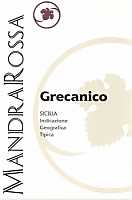
|
|
Mandrarossa Grecanico 2005 |
|
| Cantine Settesoli (Sicily, Italy) | |
| Grapes: Grecanico | |
| Price: € 7.00 | Score: |
| This wine shows a brilliant straw yellow color and nuances of straw yellow, very transparent. The nose denotes intense, clean, pleasing and refined aromas which start with hints of peach and pineapple followed by aromas of pear, apple, broom, litchi, plum and elder. The mouth has good correspondence to the nose, a crisp attack and however balanced by alcohol, good body, intense flavors, agreeable. The finish is persistent with flavors of peach, pineapple and pear. This Grecanico ages in steel tanks. | |
| Food Match: Pasta and risotto with crustaceans, Broiled crustaceans, Sauteed fish | |
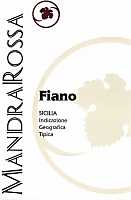
|
|
Mandrarossa Fiano 2005 |
|
| Cantine Settesoli (Sicily, Italy) | |
| Grapes: Fiano | |
| Price: € 7.00 | Score: |
| This wine shows a brilliant straw yellow color and nuances of greenish yellow, very transparent. The nose reveals intense, clean, pleasing and refined aromas which start with hints of peach, pear and apple followed by aromas of hawthorn, pineapple, apricot, litchi, white rose and broom. The mouth has good correspondence to the nose, a crisp attack and however balanced by alcohol, good body, intense flavors, agreeable. The finish is persistent with flavors of peach, pear and pineapple. This Fiano ages in steel tanks. | |
| Food Match: Pasta and risotto with fish and crustaceans, Broiled fish and crustaceans | |
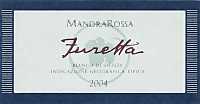
|
|
Mandrarossa Furetta 2004 |
|
| Cantine Settesoli (Sicily, Italy) | |
| Grapes: Chardonnay (80%), Fiano (20%) | |
| Price: € 12.00 | Score: |
| This wine shows an intense golden yellow color and nuances of golden yellow, very transparent. The nose reveals intense, clean, pleasing and refined aromas which start with hints of plum, pineapple and toasted followed by aromas of praline, vanilla, apple, hawthorn, honey and butter. The mouth has good correspondence to the nose, a crisp attack and pleasing smoothness, however balanced by alcohol, good body, intense flavors. The finish is persistent with flavors of plum, pineapple and praline. Furetta ferments and ages in barrique for 9 months. | |
| Food Match: Stuffed pasta, Roasted fish, Stewed fish with mushrooms, Roasted white meat | |
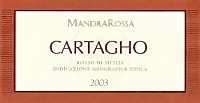
|
|
Mandrarossa Cartagho 2003 |
|
| Cantine Settesoli (Sicily, Italy) | |
| Grapes: Nero d'Avola | |
| Price: € 12,00 | Score: |
| This wine shows an intense ruby red color and nuances of ruby red, little transparency. The nose reveals intense, clean, pleasing and refined aromas which start with hints of black cherry, blackberry and plum followed by aromas of blueberry, violet, vanilla, licorice, carob, mace and pink pepper. The mouth has good correspondence to the nose, a tannic attack and however balanced by alcohol, good body, intense flavors. The finish is persistent with flavors of plum and blackberry. Cartagho ages for 12 months in barrique. | |
| Food Match: Roasted meat, Braised and stewed meat with mushrooms, Hard cheese | |
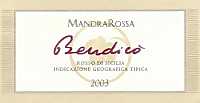
|
|
Mandrarossa Bendicò 2002 |
|
| Cantine Settesoli (Sicily, Italy) | |
| Grapes: Nero d'Avola (60%), Merlot (30%), Syrah (10%) | |
| Price: € 12.00 | Score: |
| This wine shows an intense ruby red color and nuances of ruby red, little transparency. The nose reveals intense, clean, pleasing, refined and elegant aromas which start with hints of black cherry, black currant and plum followed by aromas of blueberry, vanilla, tobacco, cocoa, cinchona, mace, eucalyptus and hints of rhubarb. The mouth has good correspondence to the nose, a tannic attack and however balanced by alcohol, full body, intense flavors. The finish is persistent with flavors of black cherry, black currant and plum. A well made wine. Bendicò ages for 14 months in barrique. | |
| Food Match: Game, Roasted meat, Braised and stewed meat, Hard cheese | |
| Cantine Settesoli - SS 115 - 92013 Menfi, Agrigento (Italy) - Tel. (+39) 925 77111 Fax. (+39) 925 77142 - Winemaker: Domenico De Gregorio - Established: 1965 - Production: 15.000.000 bottles - E-Mail: info@cantinesettesoli.it - WEB: www.cantinesettesoli.it |
Cellar Journal |
|
This section is reserved to wine producers who want to publish news and information about their business, to announce new products or just for communicating to customers information and promotions about their products and activity. Send news to be published to our e-mail address.
|
News |
|
In this section are published news and information about events concerning the world of wine and food. Whoever is interested in publishing this kind of information can send us a mail to our address.
|
Sicilian Confectionery and WineCassate, cannoli, fruits of Martorana: sweets known all over the world and heritage of past dominations in Sicily. Sweets to be matched with sweet wines and muscats of the island |
|
After having discussed about Sicilian cooking last month, it is now the time to talk about its rich confectionery, known all over the world for its specialities, heritage of Sicilian history, of all the dominations which conquered the island. There are three sources from which Sicilian confectionery takes its origin: the first one is the peasant world, in which women had the role of making sweets for religious or familiar festivities. In the past, for example, in occasion of the birth of the first son, considered a divine providence, it used to give the family a candied pumpkin's braid, tied with a red ribbon, a clear sign against jinx. The second source is from enclosed nun's convents, they still invent and prepare rich and imaginative sweets, passed till our days, which are not however an exclusivity of convents. In Mazara del Vallo, city in the province of Trapani, everyone can go to the convent in the city center where the enclosed nuns are famous for the preparation of vuccunetti, almond cookies. It is necessary to ring the door, ask for the quantity of cookies and after some minutes, through a sort of wheel, vuccunetti appear, each wrapped in aluminum foil. Through this sort of wheel, the buyer gives the money and bring home the most famous cookie of Mazara del Vallo. In Erice, in the province of Trapani, the enclosed nuns invented the famous ericini, very colored almond cookies, as well as the ericino liquor, made of herbs. The third source is more recent and it is about the refined confectionery introduced by Swiss confectioners, which moved to Sicily at the beginning of 1800's. In fact, the most famous Sicilian sweets are those belonging to the Sicilian-Swiss confectionery.
|
Among the dominations which followed one another on the island, there are many and important signs witnessing the influence of the Arab's tradition, in customs and in the enogastronomical culture, which can be seen till today. In particular, confectionery reveals evident signs of the middle eastern taste for colored and complicated preparations, such as cassata and marzipan, also known as pasta reale or almonds' paste. Masterpiece of Sicilian confectionery, well known all over the world, triumph for the eyes and taste, cassata takes its name from the Arab term quas'at, which means stewpan, referred to the round pan, used for its preparation. Other sweets of Arab origin are: cubbaita (from the Arab term qubbayt), a very sweet nougat made with honey, sesame seeds and almonds; nucatuli (from the Arab term nagal, dried fruits and jam); cupita or better copata: a very hard nougat, made in two big loaves, with nuts, albumen, sugar, honey and starch. Marzipan (from the Arab term mauthaban) came to the island after the Arab domination and became the sweet dough with which the enclosed nuns of Martorana Church's convent, in Palermo, made extraordinary little sweets having the shape and colors of fruits. This is why marzipan, in Palermo, is also called Martorana's fruits. The Arab term sharbet referred to a cold preparation, of probable Chinese origin, which from Sicily will spread all over Italy: it is the famous sherbet, the most ancient known kind of ice-cream. The Arab domination introduced ingredients such as sugar, cinnamon and pistachio, which are abundantly used for the preparation of many Sicilian sweets.
|
||||||||
|
Every province in Sicily keeps its own tradition about confectionery, as well as popular, religious and familiar holidays. Easter and All Saints' Day are the most celebrated holidays of the island. The Easter week, very heart-felt in Sicily, becomes the occasion for preparing a variety of sweets and ritual breads, associated to the religious meaning of Easter, made according to the religious traditions of every place. Ritual breads, made of of flour, eggs, sugar, marzipan and ricotta cheese are real specialities, which are prepared with the shapes of many religious symbols. Cassata, made of ricotta cheese and marzipan, decorated with candied fruit, is one of the most typical Easter cakes, although today it is produced all year long. Other typical Easter sweets are the marzipan lamb, stuffed with pistachio and candied pumpkin. The Easter lamb from Favara, which consider itself as the city of the Easter lamb, in the province of Agrigento, is very famous, promoting its product all over the world. Cassateddi, famous in the provinces of Syracuse and Ragusa, are made during the Easter period, too. In occasion of All Saints' Day, which in Palermo is particularly considered a holiday for children, who receive toys and cookies, the famous sugar dolls are prepared with the shape of ancient paladins and knights. While many sweets are common in every part of the island, others are only in some cities: pignolata in Messina, sweet omelettes in Catania, “mantecato” rice in Enna, sweet arancine, stuffed with chocolate and gelo di mellone (melon jelly), in Palermo, a sort of jelly made of melon juice, decorated with a jasmine flower; schiumette in Syracuse and impanatiglie in Ragusa. Some sweets are exclusively prepared in some periods of the year or in occasion of specific holidays celebrating saint patrons. In Palermo, on December 13th, the devotees to Saint Lucy do not eat pasta and bread for the whole day, instead they have cuccìa, a sweet made with boiled wheat and ricotta cheese, of which people from Palermo and Syracuse both claim paternity. For the holiday of Saint Peter, key shaped giant cookies, and for Saint Martin, cookies with a round loaf shape, stuffed with ricotta cheese cream. For Saint Joseph, celebrated in every city of the island, typical sweets are the so-called sfinci di San Giuseppe, which are prepared in different ways in every city of the island. In Sicily, besides Easter, Christmas Eve is another heart-felt holiday. The most famous Christmas sweets are buccellato, a big ring-shaped bun, stuffed with dried and candied fruit, nucatuli in Palermo, mustazzoli in Messina, cuddureddi in Catania, petrammennula in Modica, sweets made with cooked wine in Cammarata village, in the province of Agrigento. Ice-creams and sherbets, available in many flavors, such as “spongati”, “schiumosi”, cassate and semifreddi, are the triumph of taste, all being part of the most famous confectionery traditions. During summertime, in the period from May to October, it is common, in the morning, at breakfast and during the day, eating “granita” with or without cream and brioche. Granita - flavored ground ice - derives from sherbet and is prepared in fruit flavors, coffee, chocolate, almond's milk and jasmines. Granita, in Palermo, has its own characteristics, different from those made in Catania, Acireale and Messina. In past centuries, granita was served during the parties of nobles, between a dish and another, in order to facilitate digestion of elaborated dishes and this habit is still common nowadays.
Cannolo (ricotta cheese rolls) is one of the most famous Sicilian sweets all over the world. Its origin seems to be Arab, probably from the period of harems. It is said women from Caltanissetta, guests of kalt el nissa harem or Women's Castle, invented the famous Sicilian sweet. Cannolo consists of a fried rolled wafer, prepared with a dough of lard, flour and wine, which is wrapped in a cane or - nowadays - in specific steel shapes. The wafer, after having being fried, is stuffed with ricotta cheese and sugar. Once candied fruit was added, today Sicilians add chocolate drops instead, and, as a decoration, candied orange skins or candied cherries. Cannolo is then sprinkled with powdered sugar. Ricotta cheese used to make it, as the traditional recipe suggest, is made of sheep's milk, a very common animal in Sicily. There are some cities in Sicily to be well known for their cannoli. Piana degli Albanesi, in the province of Palermo, also famous for costumes of Albanian origin and where many people go to taste their large sized Sicilian cannoli. The same is for Dattilo, in the province of Trapani. Also in this case, not only Sicilians, but also tourists go to this city to buy impressive big sized cannoli.
|
||||||||||||
|
Modica, city in the province of Ragusa, well known for its baroque churches and for fascinating landscapes, is considered the city of Sicilian chocolate, very different from all the other types. The chocolate from Modica is very special and different from the classic chocolate: the inner part appears rich in a myriads of sugar crystals and it is more raw. In Modica, the most ancient chocolate company was established in 1880; it is still in business today and it is very famous. The history of Chocolate has a common background which, by looking back in the past, unites Sicily - especially Modica - to Spain and sets its roots in the Meso-American civilization ceremonies, in particular Aztecs, the ancient inhabitants of Mexico. After the discovery of the “New World”, Spanish had the chance to know new foods, including xocoàtl, a product which local inhabitants obtained from cocoa seeds and of which they had a great respect, as it was a food capable of giving strength and vigor, as well as being a sign of richness and health. Aztecs obtained this preparation by grinding cocoa seeds by means of a tool called “metate”, a curved stone, put on two side elements, using a special rolling-pin, also made of stone. The cocoa paste obtained this way, was mixed with spices and the dough was rubbed on the “metate” until the dough became hard. It was during their domination in Sicily that Spanish introduced the preparation of chocolate, the way they learned from that distant people. This chocolate, as opposed to what has happened in the rest of Europe, never reached an industrial phase, remaining the same during the course of centuries and till today. Not only chocolate flavored with vanilla, cinnamon and chili-pepper, but also a liquor, also produced with chili-pepper flavors, used to top ice-creams and sweets or to drink after lunch or dinner. Modica is a city where once the suggestive figure of ciucculattaru (chocolate man) existed who, without knowing that like his Spanish colleague, he brought with him “metate” on a trolley, to make in the house of his clients what was considered a food instead of a sweet.
|
|
The richness of Sicilian confectionery finds a good companion in the richness of its sweet wines for which the island is famous worldwide. Besides the wines produced with Muscat of Alexandria or Zibibbo grapes, such as the famous Moscato di Pantelleria, Muscat Blanc, with which the homonymous wines from Syracuse and Noto are made, Malvasia delle Lipari, protagonist in the Eolian islands, Sicily also offers the historical Marsala, produced in sweet styles as well. Sicilian confectionery, most of the cases rich and robust, finds good allies in the sweet wines of the island in which are frequently found the organoleptic qualities of almond, nuts and dried figs, as well as jams. Another quality of Sicilian sweet wines - which pairs very well with the rich sweets of the island - is represented by a remarkable alcohol by volume, especially in some fortified sweet wines, a category to which Marsala and many wines produced with Muscat grapes belong to. Moreover, alcohol is useful in sweets prepared with ricotta cheese, as it helps contrasting succulence. With marzipan sweets, Sicilian enology can offer countless sweet wines which be matched very well, such as Marsala Superiore demisec or sweet, as well as reserve. The same consideration is true for all the other sweets made with dried fruit - such as Buccellato from Palermo - or candied fruit, which, in this latter case, will be possible to find the same flavors in wines made with Muscat and Malvasia grapes, especially the ones from Lipari island. In sweets made with ricotta cheese - in particular cassata and cannoli - it is useful to choose a wine with an adequate alcohol volume; a good choice is represented by a sweet Marsala or fortified wines made with Muscat grapes. With Marsala Fine Rubino - the only Sicilian sweet wine produced with red grapes - can be matched cakes prepared with chocolate and - in some cases - the chocolate from Modica as well.
|
GorgonzolaGorgonzola, the homonymous city, near Milan, with “stracchino di Gorgonzola” began the fascinating adventure of a cheese, which is still very famous and appreciated all over the world |
|
Gorgonzola is a cheese which can be used in many gastronomic preparations. Many chefs use it to prepare main courses, second courses as well as desserts. Connoisseurs love to taste it on a slice of plain bread or on a slice of hot polenta.
|
|
The exact date to identify the origin of Gorgonzola is not known, however it surely has a tradition long of many years. Going back in time, it can be noticed reality and traditions are mixed together in a more or less credible legends. Some sources want its origin from the eastern slopes of northern Grigna, in the valley of Valvassina, precisely in Pasturo, in the province of Lecco. The area is rich in natural caves, where room temperature is constant between 6 and 12° C (42-53° F), an area of long cheese making traditions, perfect for aging cheese. Some believe the origin is from the homonymous city, near Milan, an important center of trading for herd, around the year 879.
The name Gorgonzola is attributed only later on: the first names with which it was known were stracchino di Gorgonzola (Gorgonzola's stracchino cheese), stracchino verde (green stracchino) or stracchino erborinato (moulded stracchino), because of the green stripes similar to parsley, called erborin in the local dialect. However, the area of Gorgonzola remained the main center for production and trading for a long time. In the Middle Ages, in the area near Milan, stracchino di Gorgonzola - at that time it was known with this name - was used to treat gastrointestinal diseases. As opposed to other cheeses, Gorgonzola had not an immediate success, however its ascent was slow and constant. Since the beginning of 1900's, the fame of Gorgonzola spread abroad, especially in England, France and Germany. Two decrees, the first in 1955 and the second in 1977, delimited the area of production and aging, becoming a denominazione di origine tutelata (denomination of safeguarded origin). In the postwar period, the technique of production was improved, therefore allowing higher quality, better hygienic conditions for all the production phases as well as constant organoleptic characteristics. The old technique was replaced with a new one, also encouraged by a cheaper production process. Gorgonzola continued to spread and to be successful, this lead to the first imitations, moulded cheeses began to be produced in many parts of Europe. Gorgonzola producers, which have been successful in transforming their work in a profitable business, began to get worried and in the 1950's began to set the first countermeasures. The first results was of 1954, when the law 125 was promulgated and which regulated typical productions and origin. The subsequent decree gave Gorgonzola cheese the “denominazione di origine protetta” (protected designation of origin) (Rule E.E.C. 2081/92), like Parmesan, Roman Pecorino cheese and others. In order to better guarantee quality, in 1970, “Consorzio per la Tutela del formaggio Gorgonzola” (Consortium for the Safeguarding of Gorgonzola Cheese) was founded, which with its inspectors ensured full compliance with the production disciplinary, in Italy as well as abroad. Gorgonzola has been recognized by the European Community as a DOP product with the Regulation 1107 of June 12th, 1996.
|
||||||||
|
Gorgonzola cheese can be produced only with the milk from the areas defined in the DOP disciplinary, located in two Italian regions: Lombardy and Piedmont. As for Piedmont are included the following provinces: Biella, Cuneo, Novara, Verbania, Vercelli and the territory of Casale Monferrato; as for Lombardy, the provinces of Bergamo, Brescia, Como, Cremona, Lecco, Lodi, Pavia and Varese. Gorgonzola is made from pasteurized cow whole and homogenized milk. The milk has to be pure - it must not be contaminated by any disinfectant, antibiotic or pesticide - otherwise the milk enzymes and the formation of moulds are seriously compromised or the quality of the product would be inferior. For this reason, it is important the scrupulous selection of the raw matter. Milk is poured into kettles and brought at a temperature of 28-32° C (82-89° F), then adding milk enzymes Lactobacillus bulgaricus and Streptococcus termophilus (the same used for the production of yogurt), rennet and selected penicillium spores, in particular Penicillium roqueforti. Once the mixture has curdled, the curd is broken up, while putting a lot of attention in creating an environment rich in oxygen in order to favor the development of Penicillium, and then transferred in special containers in order to drain the whey. This phase is very delicate: here the experience and the art of the dairyman are very important. After few minutes, the curd is placed in layers in containers known as “fassiroli” or “fascere”, in a quantity of approximately 14-15 Kg. each, and then it is allowed to stay for 36 hours in the forms, where it is continuously turned over, in order to favor a further draining of whey. This phase of production is done at a temperature of 5° C (41° F). When the curd has acquired the necessary consistency, it is marked with the logo of the Consortium and the number identifying the producer, then it is transferred in order to undergo the phase of salting. In this phase, the forms are transferred to a room, the so-called “purgatory” (cellars with a temperature of 20-22° C (68-71° F) and a humidity of 90-95% suitable for aging). The cheeses remain in the maturing cellars, at a temperature of 2-7° C (35-44° F) and a humidity of 85-95%, for a period from 50 to 90 days, according to the type (sweet or piquant). After three or four weeks, the cheeses are holed. Long metallic needles hole the cheeses in order let the air in, therefore allowing the development of the cultures previously introduced in the curd. The air creates the ideal and natural conditions for the development of Penicillium, responsible for the blue-green veining making Gorgonzola cheese unique. At the end of the aging process, the cheeses undergo a further check in order to assess quality. The forms found to have the right quality are then cut in two or more pieces and each piece is wrapped in aluminum foil with the “g” trademark. Before being commercialized, Gorgonzola must undergo an aging process, which is of two months for the sweet style, three months for the piquant one. The present production is of about 3,600,000 forms, 430,000 quintals of product, 28-29% of which is exported. Foreign countries, in which are found most of Gorgonzola consumers are France, Germany - which import more than 50% of total exports - followed by Switzerland, Great Britain, Belgium, Holland, Austria, United States of America and Canada.
|
||||
|
Gorgonzola is a straw-white raw curd cheese, whose green veining is the result of the moulding process. The external crust is hard, rough and reddish. There are three different styles of Gorgonzola cheese:
Milk enzymes are indispensable for the production of this cheese and are similar to the bacilli contained in yogurt and even more, to the ones used for the products commonly sold in pharmacies and used against diarrhea. The mould spores responsible for the distinctive greenish veining of the cheese belong to the Penicillium Roqueforti species, closely related to the more famous Penicillium Notatum from which penicillin is produced. Perhaps, it is because of this people in charge of aging Gorgonzola are particularly resistant to infective diseases, or at least it is believed so. However this is the border between legend and reality. In any case, milk enzymes, moulds and penicillin - or at least the substances produced from their metabolism - surely have a positive effect on human organism. Gorgonzola, according to a nutritional point of view, is rich in vitamins, mineral salts, proteins, with a moderate quantity of fats. In short, 100 grams of Gorgonzola contains: 19 gr. of proteins; 26 gr. of fats; 360 mg. of phosphor; 420 mg. of calcium; 120 mg. of potassium; 70 mg. of cholesterol; vitamins A, B1, B2, B6, B12 and PP. Hundred grams of Gorgonzola provide 330 kcal. To fully enjoy the organoleptic qualities of sweet Gorgonzola, it is best to take it out from the fridge at least half an hour before serving. It is a very special cheese, which must be consumed fresh, it is a live product, continuously aging: in case it is kept for a long time in the fridge, it can even get a remarkable strong taste, in this case it can be mixed with cream and butter and used for the preparation of fine sauces. Thanks to its organoleptic characteristics, Gorgonzola is suitable for many gastronomic preparations. Many chefs use it to prepare main courses, second courses and even desserts. Connoisseurs like to enjoy it on a slice of plain bread or on a slice of hot polenta. Originally, all the cheeses are marked on both faces, but this does not interest the consumer. To be sure of having bought an authentic Gorgonzola, before buying, it is best to make sure the “g” trademark is printed on the aluminum foil wrapping the product. This logo is exclusive and distinguishes the original product.
|
AquavitaeReview of Grappa, Distillates and Brandy |
|
|
| Distillates are rated according to DiWineTaste's evaluation method. Please see score legend in the "Wines of the Month" section. |
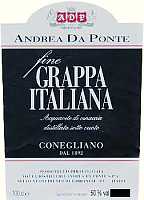
|
|
Fine Grappa Italiana |
|
| Andrea Da Ponte (Veneto, Italy) | |
| Raw matter: Pomace of Merlot and Cabernet | |
| Price: € 14.00 - 1l | Score: |
| This grappa is colorless, limpid and crystalline. The nose denotes intense, clean and pleasing aromas of pear, raspberry, black cherry, hazelnut and licorice, with almost imperceptible alcohol pungency. In the mouth has intense flavors with perceptible alcohol pungency which tends to dissolve rapidly, good correspondence to the nose, balanced sweet hint, pleasing smoothness. The finish is persistent with flavors of raspberry and licorice. This grappa is distilled with traditional continuous and discontinuous alembic stills. Alcohol 50%. | |
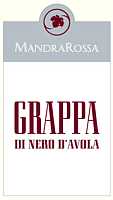
|
|
Grappa di Nero d'Avola Mandrarossa |
|
| Cantine Settesoli (Sicily, Italy) | |
| (Distiller: Fratelli Brunello) | |
| Raw matter: Pomace of Nero d'Avola | |
| Price: € 15.00 - 50cl | Score: |
| The grappa is colorless, limpid and crystalline. The nose reveals intense, clean and pleasing aromas of plum, black cherry, licorice, hazelnut and blackberry, with almost imperceptible alcohol pungency. In the mouth has intense flavors with perceptible alcohol pungency which tends to dissolve rapidly, balanced sweet hint. The finish is persistent with flavors of plum and blackberry. This grappa is produced with a discontinuous steam operated alembic still. Alcohol 45%. | |
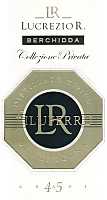
|
|
Filuferru Collezione Privata |
|
| Lucrezio R. (Sardinia, Italy) | |
| Raw matter: Pomace of white and red grapes | |
| Price: € 18.00 - 50cl | Score: |
| This distillate is colorless, limpid and crystalline. The nose reveals intense, clean and pleasing aromas of anise, apple, raspberry, plum, peach and licorice, with almost imperceptible alcohol pungency. In the mouth has intense flavors with perceptible alcohol pungency, dry taste, balanced sweet hint. The finish is persistent with flavors of anise, plum and apple. This Filuferru is distilled with a bainmarie alembic still. Alcohol 45%. | |

|
|
Grappa di Erbaluce di Caluso |
|
| Revel Chion (Piedmont, Italy) | |
| Raw matter: Pomace of Erbaluce | |
| Price: € 12.50 - 50cl | Score: |
| This grappa is colorless, limpid and crystalline. The nose reveals intense, clean and pleasing aromas of apple, plum, mown grass, hazelnut and broom, with almost imperceptible alcohol pungency. In the mouth has intense flavors with perceptible alcohol pungency which tends to dissolve rapidly, pleasing roundness, balanced sweet hint. The finish is persistent with flavors of apple, plum and hazelnut. This grappa is distilled with a steam operated alembic still. Alcohol 45%. | |
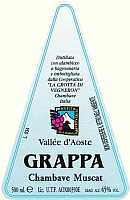
|
|
Grappa Chambave Muscat 1999 |
|
| La Crotta di Vegneron (Vallée d'Aoste, Italy) | |
| Raw matter: Pomace of Muscat Blanc | |
| Price: € 24.50 - 50cl | Score: |
| This grappa is colorless, limpid and crystalline. The nose reveals intense, clean and pleasing aromas of grape, peach, sage, apple, pear and honey, with almost imperceptible alcohol pungency. In the mouth has intense flavors with perceptible alcohol pungency which tends to dissolve rapidly, pleasing smoothness, balanced sweet hint. The finish is persistent with flavors of grape, peach and pear. This grappa is distilled in bainmarie alembic stills. Alcohol 45%. | |
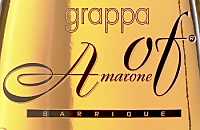
|
|
Grappa of Amarone Barrique |
|
| Bonollo Umberto (Veneto, Italy) | |
| Raw matter: Pomace of Corvina, Rondinella and Molinara | |
| Price: € 37.00 - 70cl | Score: |
| This grappa shows a brilliant amber yellow color, limpid and colorless. The nose reveals intense, clean, pleasing and refined aromas of prune, dried fig, licorice, star anise, black cherry, honey, tobacco, hazelnut, nutmeg, cocoa and white pepper, with almost imperceptible alcohol pungency. In the mouth has intense flavors with perceptible alcohol pungency which tends to dissolve rapidly, pleasing smoothness, balanced sweet hint, agreeable. The finish is persistent with flavors of prune, hazelnut and dried fig. This grappa is produced with the double distillation system and it is aged in barrique. Alcohol 42%. | |
Wine Parade |
|
|
| The best 15 wines according to DiWineTaste's readers. To express your best three wines send us an E-mail or fill in the form available at our WEB site. |
| Rank | Wine, Producer | |
|---|---|---|
| 1 |
| Amarone della Valpolicella Classico 1998, Santa Sofia (Italy) |
| 2 |
| Trento Talento Brut Riserva Methius 1998, Dorigati (Italy) |
| 3 |
| Colli Orientali del Friuli Rosazzo Bianco Terre Alte 2002, Livio Felluga (Italy) |
| 4 |
| Aglianico del Vulture La Firma 2002, Cantine del Notaio (Italy) |
| 5 |
| Riesling Central Otago 2004, Felton Road (New Zealand) |
| 6 |
| Palazzo della Torre 2000, Allegrini (Italy) |
| 7 |
| Brunello di Montalcino 1999, Castello Banfi (Italy) |
| 8 |
| Montepulciano d'Abruzzo Riparosso 2001, Illuminati (Italy) |
| 9 |
| Amarone della Valpolicella Classico 2000, Zenato (Italy) |
| 10 |
| Wine Obsession 2001, Vignamaggio (Italy) |
| 11 |
| Chablis Grand Cru Les Clos 2002, Domaine Billaud-Simon (France) |
| 12 |
| Rêve 2001, Velenosi Ercole (Italy) |
| 13 |
| Notarpanaro 1999, Taurino (Italy) |
| 14 |
| Chianti Classico Riserva Novecento 2000, Dievole (Italy) |
| 15 |
| Harmonium 2001, Firriato (Italy) |
| |||||||
Privacy Policy | |||||||


| Copyright © 2002-2024 Antonello Biancalana, DiWineTaste - All rights reserved |
| All rights reserved under international copyright conventions. No part of this publication and of this WEB site may be
reproduced or utilized in any form or by any means, electronic or mechanical, without permission in writing from DiWineTaste. |